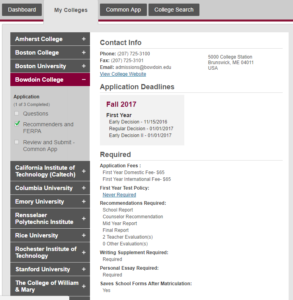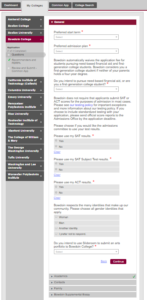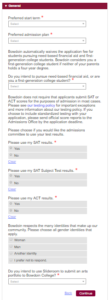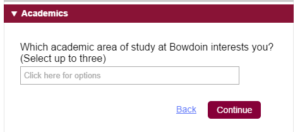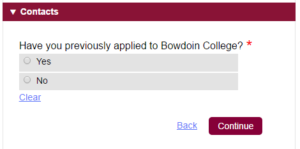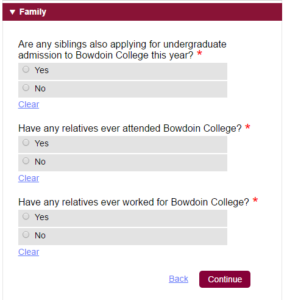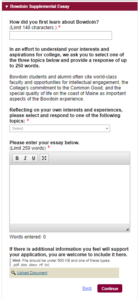The Ultimate Guide to Applying to Bowdoin College
As one of the best liberal arts colleges in the country, Bowdoin College may not be quite as famous as its Northeastern cousins in the Ivy League, but this small undergraduate institution is a gem in its own right. From its commitment to academic excellence to its exceptional dining halls to its environmental awareness, Bowdoin provides a unique and character-filled undergraduate experience for motivated and curious students.
Bowdoin College has a deep historical grounding, and has been around since its location in Maine was still part of Massachusetts. Alumni include such fixtures of American history as Henry Wadsworth Longfellow and Nathaniel Hawthorne, along with many members of Congress, the Supreme Court, and even a president (Franklin Pierce). However, the school takes pains not to be held back by tradition, and encourages its students to take intellectual risks and open new lines of inquiry.
Are you ready to “lose yourself in generous enthusiasms and cooperate with others for common ends,” as a past president of Bowdoin wrote? In this ultimate guide, you’ll find an overview of what makes Bowdoin College a great school, the requirements of the application, and how to navigate its competitive admissions process.
Introducing Bowdoin
Bowdoin College, originally chartered in 1794, is a small college that offers undergraduate students a “well-rounded” and highly-regarded liberal arts education. It’s often considered to be on par with the larger schools of the Ivy League in terms of educational quality; we’ve covered it before in our CollegeVine post on finding success and excellence outside the Ivy League. The popular U.S. News and World Report rankings place Bowdoin in a tie for fourth-best college in the National Liberal Arts Colleges category.
Located in the small New England town of Brunswick, Maine, about 26 miles outside of Portland, Bowdoin’s setting provides easy access to Maine’s natural treasures. (Note that although there is a town called Bowdoin in Maine, this town is not the location of the college.) Students regularly take advantage of this access; in fact, Bowdoin’s Outing Club, a student group which organizes outdoor trips, is the largest student group on the campus.
In addition to the main campus in Brunswick, Bowdoin also owns two other parcels of land on two islands in the Atlantic Ocean, which are used for marine and coastal research.
Currently, 1,839 students are enrolled at Bowdoin, all of whom are undergraduates. Students can choose between 32 standard majors and 8 interdisciplinary majors, or create their own majors. The most popular majors are in the fields of political science, economics, mathematics, and biology. A range of academic minors are available to supplement students’ major choices.
As a liberal arts college, Bowdoin’s curriculum requires students to complete a number of distribution and division requirements alongside their major in order to obtain a broad-based education. The famous “Offer of the College,” a poetic statement written by past Bowdoin president William DeWitt Hyde in 1906, is often cited as a basis for the shcool’s educational principles and goals, from intellectual development to appreciation for the arts to the formation of lifelong friendships and networks.
Bowdoin takes pride in cultivating a high quality of life for its student body. The dining halls on campus serve fare that’s often considered to be the best collegiate food in the country, including fresh produce from the college’s own organic garden. A semi-residential “college house” system was introduced relatively recently, and while not all students choose to live in their houses, all students have a house affiliation. The college is also heavily involved in improving the environmental impact of its campus, and hopes to become carbon-neutral by 2020.
Besides enjoying the outdoors, students take advantage of a broad range of groups and activities. The campus newspaper, The Bowdoin Orient, has the distinction of being the longest-running college weekly published in the United States, and has been lauded for its quality by the Collegiate Associated Press. Other activities include collegiate standards like a cappella groups and 31 varsity athletic teams, as well as more unusual offerings like a group focused on sustainable eating and a RoboCup robotic soccer team.
Bowdoin College Admissions Information
Getting into Bowdoin is a very competitive process. For the class of 2020, the school received 6,799 applications in total and accepted 1,009 students, making their most recent acceptance rate 14.8%. Over half of the members of the matriculating class were accepted through one of Bowdoin’s Early Decision programs, which we’ll go over later in this post.
One unique feature of the admissions process is that for most applicants, no standardized test scores are required to be submitted as part of the admissions application. (You can still submit test scores if you wish to include them, and the majority of students do choose to submit scores.) While several other colleges have instituted testing-optional admissions procedures in recent years, the college’s venerable testing-optional program has been around since 1969.
For the class of 2018, 30% of students who ended up matriculating at Bowdoin did not submit standardized test scores with their applications, showing that the college really does take this option seriously. However, the school does require all matriculating students to eventually submit test scores before enrollment, both for academic placement purposes and as part of the college’s ongoing research into the subject of standardized testing. You can read more about Bowdoin’s testing-optional admissions policy on its website.
If Bowdoin isn’t focused on the metric of standardized test scores, then what is the college looking for? According to its website, Bowdoin is seeking students who are bright, engaged, and curious, and who value diversity. Academic achievement (with or without test scores) is an important factor in admissions decisions, as are the applicant’s extracurricular and community involvement, the comments of the recommenders, and applicant’s overall “character and personality.”
Bowdoin accepts transfer applications, though the transfer application process is even more competitive than the first-year application process. The transfer admissions web page states that each year, the college receives approximately 150 to 200 transfer applications and ends up admitting 5 to 20 students, meaning that the acceptance rate could be anywhere from 13.3% down to 2.5%, depending on how many openings the college ends up having for transfer students, which can vary greatly from year to year.
Paying for Bowdoin
Tuition at Bowdoin for the 2016-2017 school year is $49,416, and the total cost of attending Bowdoin this year is estimated at $65,590. This figure does not include the cost of traveling to and from the collece, which will vary depending on where the individual student lives. 47% of students receive financial aid to assist with the cost of their education.
Bowdoin’s financial aid is entirely need-based, and the college guarantees to meet 100% of the demonstrated financial need of each admitted student. Students are not required to take out loans as part of their financial aid packages, though loans are available as a financing option for students or parents.
To apply for financial aid, applicants from the United States will need to submit the CSS Profile, the FAFSA, and their family’s tax returns by the same date as their admissions applications. the school will use these documents to determine how much the student and their family can contribute to the cost of college, and create a financial-aid award that covers the rest of the cost of a Bowdoin education.
For international applicants, whether first-year or transfer, admissions decisions are made on a need-aware basis, meaning that the student’s ability to pay for college may play a role in whether they are admitted. Some institutional financial aid is available for international students, however. Basically, Bowdoin will only admit a limited number of international students with financial need, but will guarantee to meet the need of all students they do admit.
In order to apply for financial aid, international applicants should submit the CSS Profile at the same time as their admissions applications. It’s important to note that international applicants who do not apply for financial aid at this time will not be considered for financial aid later on in their time at Bowdoin.
The Bowdoin Application
Bowdoin offers the majority of its applicants two different application options: the Common Application and the Coalition Application. These two application formats ask for much of the same basic information, but go about asking for that information in different ways, and have different standard essay question options. Neither application format is preferred by the office of admissions, so you can feel free to use whichever one suits you best.
Applicants can also choose between three different application timelines using either the Common App or the Coalition App: Early Decision I (ED I), Early Decision II (ED II), and Regular Decision (RD). Both ED timelines allow students to make a binding commitment to Bowdoin and receive their admissions decision earlier than applicants using the more popular RD timeline.
If you’re absolutely sure that Bowdoin is your first choice and you will happily attend if accepted, one of the ED rounds might be a good option for you — as we mentioned, the college fills a substantial percentage of its matriculating class through the ED rounds.
ED I applicants submit their applications by November 15th and receive notification of their admissions decision by mid-December. ED II applicants submit their applications by January 1st for notification by mid-February. RD applicants also submit their applications by January 1st but won’t receive their admissions decisions until early April.
Some prospective first-years may be able to submit their applications through the QuestBridge National College Match program, which seeks to connect talented low-income high school students with competitive colleges. However, in order to apply this way, applicants will need to have already applied to the QuestBridge program and have been named finalists in that program. If you’re a QuestBridge finalist and you’re interested in Bowdoin, your QuestBridge advisors will be able to give you more instructions on how to go about applying.
As we mentioned, Bowdoin also accepts applications from potential transfer students, primarily for the fall semester. Transfer applications, which should be submitted through the Common App only, are due by March 1st, and these applicants can expect to hear back by mid-May. These due dates are the same for prospective spring transfers, who should keep in mind that very few spring transfers are admitted.
Common Application Supplement
To apply to Bowdoin, you’ll first need to create a Common App profile and add the school as one of your colleges, then complete the basic Common App questions. For more advice on how to navigate the Common App, take a look at the CollegeVine User’s Guide to the Common Application, as well as our targeted posts regarding how to fill out the sections on your demographics, citizenship, academics, activities, awards, and more.
After you’ve completed the main portion of the Common App, you’ll move on to answering the school-specific questions and essay. To get to Bowdoin’s school-specific questions, navigate to your My Colleges tab and click on “Bowdoin.” You’ll see the following screen, as illustrated by a sample applicant’s profile:
On the left side, under Bowdoin’s tab and the heading that says “Application,” click on the word “Questions.” You’ll see the screen shown below.
These supplemental questions are divided into five sections: General, Academics, Contacts, Family, and Bowdoin Supplemental Essay. Click on the section headers to access the questions in each section. Below, we’ll offer some advice on how to answer.
For the General section, you’ll answer the following questions:
- Preferred start term: Choose “Fall 2017” from the drop-down menu.
- Preferred admission plan: Choose Early Decision (ED I), Early Decision II (ED II), or Regular Decision from the drop-down menu.
- Bowdoin automatically waives the application fee for students pursuing need-based financial aid and first-generation college students. The school considers you a first-generation college student if neither of your parents holds a four-year degree. Do you intend to pursue need-based financial aid, or are you a first-generation college student?: Read the statement, then select the option that applies to you and your family from the drop-down menu.
- Bowdoin does not require that applicants to submit SAT or ACT scores for the purposes of admission in most cases. Please see our testing policy for important exceptions and more information about our testing policy. If you choose to include standardized testing with your application, please send official score reports to the Admissions Office by the application deadline. Please choose if you would like the admissions committee to use your test results: As we’ve mentioned, Bowdoin has a long-standing testing-optional admissions policy for most applicants. To answer this question, you’ll need to select yes or no as to whether you’d like the college to use your SAT scores, your ACT scores, and your SAT II subject test scores. You’ll need to carefully consider whether this will help or hurt your application. You can learn more about the testing-optional policy on the school’s website.
- Bowdoin respects the many identities that make up our community. Please choose all gender identities that apply: Choose between “Woman,” “Man,” “Another Identity,” and “I prefer not to respond.” If you choose “Another Identity,” you’ll be prompted to enter that identity into a text box if you wish.
- Do you intend to use Slideroom to submit an arts portfolio to Bowdoin College?: Before answering “Yes or “No” to this question, check out our CollegeVine blog post on whether you should submit an arts supplement. You can find instructions on submitting Bowdoin’s Arts Supplement on the college’s website.
For the Academics section, you’ll answer the following question:
- Which academic area of study at Bowdoin interests you? (Select up to three): Select the three options from the drop-down menu that interest you most. You don’t need to rank these choices, and your answer is not at all binding, so you shouldn’t spend too much time agonizing over it. See the Bowdoin website for more information about each of these areas of study.
For the Contacts section, you’ll answer the following question:
- Have you previously applied to Bowdoin College?: Select “Yes” or “No.” If you select “Yes,” you’ll be prompted to provide the month and year you previously applied to the school.
For the Family section, you’ll answer the following questions:
- Are any siblings also applying for undergraduate admission to Bowdoin College this year?: Select “Yes” if you have one or more siblings who are applying to Bowdoin this year; otherwise, select “No.” If you select “Yes,” you’ll be prompted to provide their names and relationships to you.
- Have any relatives ever attended Bowdoin College?: Select “Yes” if you have any relatives who have attended Bowdoin; otherwise, select “No.” If you answer “Yes” for this question, you’ll be prompted to enter additional information about these relatives.
- Have any relatives ever worked for Bowdoin College?: Select “Yes” if you have any relatives who have been employed by the college; otherwise, select “No.” If you answer “Yes,” you will be prompted to enter additional information about these relatives.
Finally, for the Bowdoin Supplemental Essay section, you’ll respond to the following prompts:
How did you first learn about Bowdoin? (Limit 140 characters)
In an effort to understand your interests and aspirations for college, we ask you to select one of the three topics below and provide a response of up to 250 words. Bowdoin students and alumni often cite world-class faculty and opportunities for intellectual engagement, the College’s commitment to the Common Good, and the special quality of life on the coast of Maine as important aspects of the Bowdoin experience. Reflecting on your own interests and experiences, please select and respond to one of the following topics:
- Intellectual Engagement
- The Common Good
- Sense of Place
For a detailed breakdown of how to respond to these first two prompts, check out our CollegeVine guide to How to Write the Bowdoin College Application Essays 2016-2017.
If there is additional information you feel will support your application, you are welcome to include it here.
Responding to this question is optional, but if you feel it’s necessary to provide additional information, you can upload a document here. Remember, this section shouldn’t duplicate information that is already found elsewhere in your application. If you have exceptional personal circumstances that you feel you need to specify, take a look at the CollegeVine blog for advice on how to explain your situation.
Coalition Application
The Coalition App is a newcomer to the college admissions world; created by the Coalition for Access, Affordability, and Success, it’s available for the first time during the 2016-2017 college application season. Like the Common App system, the Coalition App system allows you to fill out one form that is shared with all the colleges you select from its member schools, making the process of filling out applications a fair amount easier.
As we mentioned above, the Coalition App asks for much of the same basic information as the Common App in terms of your academic performance, activities, achievements, and other standard admissions factors. However, the Coalition App’s focus differs somewhat, and it may ask these questions in a different way than the Common App does. If you’re considering Bowdoin or another Coalition App member school, it’s worth looking over the Coalition App website to see what it offers.
In order to apply using the Coalition App, you’ll first need to create a Coalition App account online. Once you create that account, you can fill out your profile, add colleges to your list, and answer the non-school-specific application questions. The Coalition App has its own set of essay prompts to choose from; for a detailed description of how to respond to these prompts, check out the CollegeVine blog post on How to Write the Coalition Application Essays 2016-17.
For the 2017-17 application season, the Coalition App supplemental essay required for Bowdoin uses the same prompt as the college’s Common App supplemental essay. Consult the Common App section above for advice on how to address this prompt.
Interviewing at Bowdoin
Interviews are not required as part of the Bowdoin application process, and you won’t be penalized if interviewing is not possible for you, but they are strongly encouraged for applicants who can arrange them. The admissions representatives who review applications value the personal insight that an interview may provide, and your interviewer’s notes become part of your admissions file.
On-campus and off-campus interviews are available for Bowdoin applicants. (You can only choose one of these options, however.) You’ll need to be proactive and request an interview, if you would like to have one, using one of the methods listed below.
If you’re able to visit the campus at some point, you can register for an on-campus interview conducted by an admissions representative or a trained Bowdoin senior. You don’t need to have already submitted your application in order to request an interview. While on campus, you can also take advantage of tours, information sessions, and class visits to learn more about life at the college. You can even sign up for an overnight visit, where you’ll stay with a student host.
Interested students who aren’t able to have an on-campus interview can request an off-campus interview with an alumni interviewer, arranged for a time and place that’s more convenient for the student. You can learn more about how to request one of these interviews on the Bowdoin website. Keep in mind that these interviews are in high demand, and the college cannot guarantee they’ll be able to arrange one for you.
International applicants can request an off-campus alumni interview through the same process domestic students use, although interviewer availability is limited. Applicants from China can submit an interview using a third-party interview service, such as InitialView or Vericant, if they wish; they also have the option of submitting an additional letter of recommendation instead.
Additional Application Requirements
Applicants to Bowdoin must submit the following documents along with their Common or Coalition App and its Bowdoin-specific application questions:
- Application fee of $65, or application fee waiver.
- Secondary school counselor evaluation, completed by your guidance counselor.
- School report, also competed by your counselor, and official transcript.
- Two teacher recommendations from teacher who have taught you in an academic subject during your junior or senior years of high school.
- Optional for most applicants: official standardized test scores, sent by the testing agency directly to Bowdoin. The exception is home-schooled applicants, who must submit scores from either the SAT or the ACT, as well as scores for two or more SAT II subject tests.
- International students for whom English is not their first language will need to submit scores from the TOEFL or IELTS unless they have attended four years of secondary school taught in English. Students from countries that use national university entrance exams must provide their scores to Bowdoin as well. For more information about international applicant requirements, see the Bowdoin website.
In addition to the admissions application, if you’re applying for financial aid, you’ll need to submit your financial aid documents separately. While SAT and ACT scores are not used to make admissions decisions for most students and are not required during the application process, if you’re accepted, you’ll eventually need to provide those scores to the college for use in advising and placement.
Hearing Back from Bowdoin
ED I and ED II applicants will receive their admissions decisions by mid-December and mid-February, respectively. At this time, they may be accepted, rejected, or deferred.
If you’re accepted in one of the ED rounds, you’ll be expected to enroll at Bowdoin and withdraw any other college applications you’ve already submitted, as the ED agreement you signed is binding. If you’re rejected from the school in either ED round, your application will not be reconsidered later in the process, and you’ll need to focus on your other college options instead. (You may be able to apply to Bowdoin at a later date as a transfer student.)
If you’re deferred in either ED round, your admission will be reconsidered in the RD round with the rest of the RD application pool, and you’ll have another shot at admission. Deferred applicants are released from their ED contract and are no longer required to attend Bowdoin if admitted. We’ll go over more details of what deferral means for you later in this post.
Applicants who are in the RD pool, including deferred ED applicants from either round, will receive their admissions decision in mid-April. If you’re accepted in the RD round, you’ll have until May 1st to make a decision and commit to Bowdoin. If you’re rejected in the RD round, unfortunately, you’ll need to make other plans.
Some applicants are neither rejected nor accepted in the RD round, but instead are placed on the waitlist. These students may be reconsidered for admission later on if open spots remain in the first-year class after the May 1st response deadline but before classes start. We’ll address the waitlist process in greater detail below.
Deferrals and the Waitlist
If you apply to Bowdoin in either the ED I round or the ED II round, there’s a fair chance you may be deferred. In the ED I round for the class of 2015, for example, the college received 568 applications, accepted 189 applicants, and deferred another 189 applicants. Students who are deferred will have their applications reviewed again according to the RD timeline and will receive an admissions decision by mid-April.
Deferred applicants still have a chance at being admitted, so if you’re deferred, you should definitely keep on top of your application. It’s a good idea to write to the admissions office reiterating that you’re still interested in Bowdoin. You can include in this letter any new information that’s come up since your initial application and that makes you a stronger candidate, such as improved grades and test scores or new awards and accomplishments. Of course, you’ll also need to apply to other colleges and make plans in case you’re not accepted.
If you’re waitlisted in the RD round, you face a similar situation to that of deferred applicants, and there are a few things you should keep in mind. First of all, waitlist admission to Bowdoin is extremely competitive, and is entirely dependent upon how many spots become available in the matriculating class after the response deadline. The number of applicants admitted off the waitlist is generally less than 50, and in some recent years, it’s been substantially lower. In 2012, Bowdoin accepted zero applicants off their waitlist.
Waitlisted applicants can choose whether or not to accept a spot on the waitlist and be considered for future admission, and this choice is entirely up to you. If you choose to remain on the waitlist, you’ll need to fill in an online form to confirm your spot and remind Bowdoin that you’re interested in attending. If you’re offered admission off the waitlist, you’ll be informed of your acceptance between May 1 and the end of July.
As with deferred applicants, you can also contact the admissions office with any new information to add to your application. Still, since the waitlist acceptance rate is so low and variable, we would definitely advise you to make plans to attend another college, including submitting a deposit if necessary.
Something else to keep in mind is that Bowdoin’s financial aid budget for accepted waitlist applicants is often limited. This means that Bowdoin has a need-aware admissions policy for waitlisted applicants, and will only accept applicants with financial need at this point if it has the funds to do so.
Do the academic excellence and “sense of place” you’ll find at Bowdoin sound like a great fit for you? Check out the Bowdoin website for more information about academic departments, student activities, and life on campus. Don’t forget to take a look at our CollegeVine blog post How to Write the Bowdoin College Application Essays 2016-2017.
Curious about your chances of acceptance to your dream school? Our free chancing engine takes into account your GPA, test scores, extracurriculars, and other data to predict your odds of acceptance at over 500 colleges across the U.S. We’ll also let you know how you stack up against other applicants and how you can improve your profile. Sign up for your free CollegeVine account today to get started!
